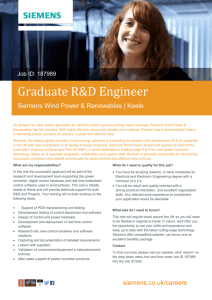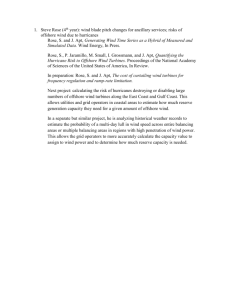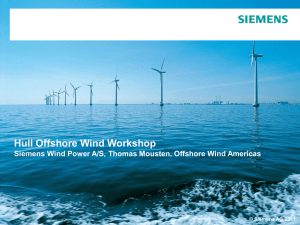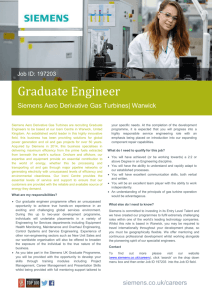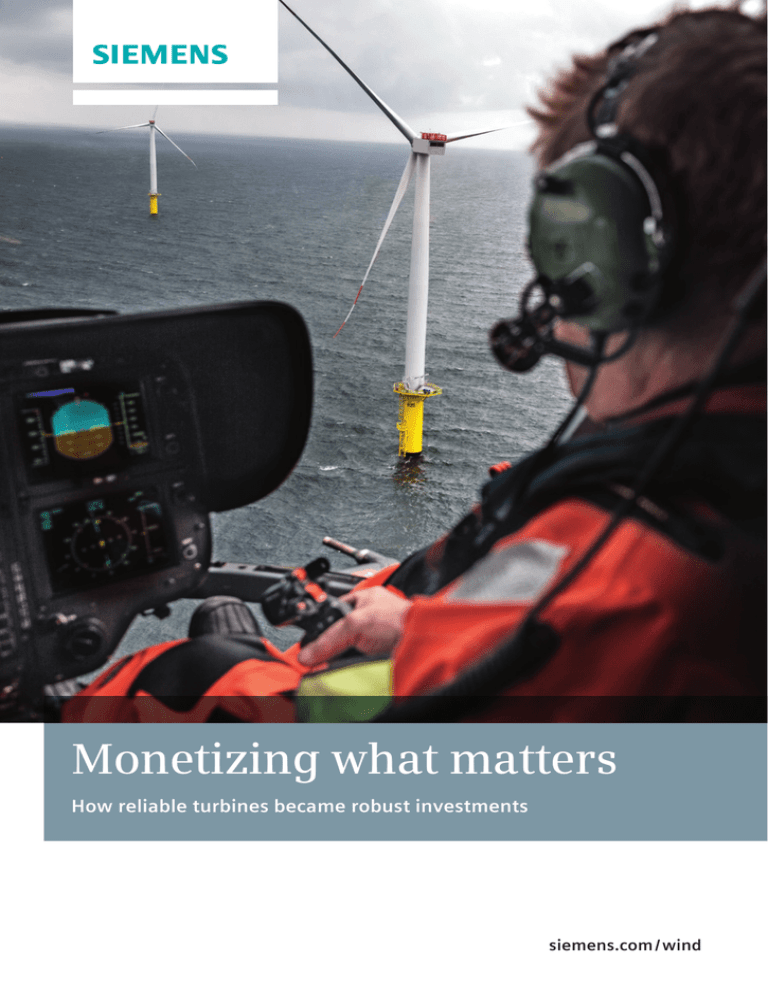
Monetizing what matters
How reliable turbines became robust investments
siemens.com / wind
Offshore wind power
comes of age
From reliable turbines...
...to robust investments
In the quarter-century since Siemens installed the world’s
first offshore wind power plant off Denmark, the capacity
of offshore turbines has increased more than tenfold.
Offshore wind is now established as a viable energy
source and a reliable way to achieve emissions targets.
Once financed almost exclusively by utilities providers,
offshore is now acknowledged by bankers as a dependable
asset. For many investors, the question is no longer
whether to invest in offshore. Rather which offshore
provider will make the most reliable partner long term.
Having installed the first-ever offshore wind turbines at
Vindeby in 1991, Siemens was the first company to face –
and overcome – the substantial challenge of maintaining
and improving unproven offshore technologies. By taking
the lead in maturing offshore wind power products and
services, Siemens gradually acquired an unparalleled
wealth of experience and expertise – to the benefit of its
investing partners today.
Siemens’ experience gave confidence to commit
resources to the offshore industry long term. And taught
the company how best to allocate those resources to
deliver maximum reliability. For Siemens’ partners, this
combi­nation of experience, reliability, and long-term
commitment helps make Siemens Wind Power Offshore
Techno­logy a robust investment.
“A gram of experience is worth
a ton of theory.” U.K. Prime Minister Robert Gascoyne-Cecil
3
Excellence at every stage
Turbine Reliability
Despite the difference in scale between the first, 450 kW offshore wind turbines
that Siemens installed in 1991 and the multi-megawatt models currently deployed
offshore, many offshore industry standards can be traced back to that first site at
Vindeby.
Indeed, Siemens engineers used the experience gained from this project to further
improve design, sourcing, and manufacturing. A three-stage manufacturing cycle
evolved that still continues from platform to platform. Together with a rigorous
testing regime and product platform strategy, this cycle lays the groundwork for
product maturity and reliability.
Stage 1: Reliable design
Siemens builds reliability into every wind turbine platform by reusing proven components, design principles, and technologies from one product generation to the next.
The more components from the previous generation, the more predictable performance and service with the new platform.
Stage 2: Reliable sourcing
Successful sourcing requires intensive monitoring of the components provided
by suppliers and subsuppliers. The exhaustive efforts of Siemens’ quality-control
teams is characterized by a dedication toward always complying to Siemens’
quality standards.
Stage 3: Reliable assembly
Drawing inspiration from carmakers, in 2010 Siemens took the first step toward
industrializing wind turbine manufacturing, with the introduction of moving-line
assembly. This ensures higher and more consistent quality standards and enables
more efficient use of the company’s manufacturing facilities.
G2
Platform
Design
Sourcing
Assembly
4
G4
Platform
D3
Platform
D7
Platform
Every Siemens platform builds on the strengths of its predecessor,
from the G2 introduced in 1999 to the current D7. Platforms with
a ‘D’ in the name use direct drive technology. ‘G’ stands for geared.
...far beyond industry
standards
Pre-prototype testing
Uncompromising
testing...
Whereas certification of structural safety
and electrical systems is a legal requirement, validating the robustness of other
systems and components effectively
remains optional. To help safeguard our
partners’ investments, Siemens also rigorously tests materials, major components,
and modules prior to prototype testing.
Prototype testing
Higher and more consistent offshore
wind speeds increase returns for investors
and operators alike, but they also present
significant challenges. The sheer scale of
offshore maintenance operations makes
investment safeguards such as thorough
testing all the more crucial for offshore
wind turbines.
Pioneering procedures
Exceeding expectations
In response to the increasing importance
of offshore wind power and the challen­
ges of the offshore environment, Siemens
introduced a structured approach to testing. Blades, bearings, gearbox, and other
major components were pushed to their
limits and the first G4 turbine – the
SWT-3.6-107 – was subjected to more
than 200 separate, highly accelerated
lifetime tests. These procedures have
been repeated for every new turbine
design since.
As the first company to introduce an allembracing test program for offshore
wind turbines, Siemens offers its partners
un­rivaled experience of test procedures.
To deliver the consistent quality Siemens
customers expect, these procedures have
been developed even further than most
requirements specified by the industry’s
certifying bodies.
6
2004 saw two milestone achievements
for the offshore sector: the launch of the
first dedicated offshore wind turbine
platform (the Siemens G4) and the introduction of the first fully fledged offshore
test program. Siemens’ partners were the
exclusive beneficiaries of both.
Prototype turbines provide valuable operational experience. They help to verify
initial calculations from the design stage
and are essential to further research and
development. Prototype test results feed
into the verification and implementation
of service programs as well as solutions
for new turbine designs.
Material, component, and module testing
takes place at Siemens’ dedicated test sites
in Aalborg or Brande, both in Denmark.
Together, they form the largest windturbine testing facility in the world.
Turbine Reliability
Turbine testing comprises three main
stages: structural, mechanical, and electrical testing. Before the first prototype
turbine can be erected in the field, a
certification authority must verify its
overall structural capacity.
1
2
3
4
Tested at every level
Step
4
Step
3
Step
2
Step
1
Prototype test
Module test
Component test
Material test
7
2015
Gwynt y Môr
160 turbines
3,600 kW
From world’s first to
world-class
2014
West of Duddon Sands
108 turbines
3,600 kW
2012
London Array Limited
175 turbines
3,600 kW
2003
Nysted
72 turbines
2,300 kW
1991
Vindeby
11 turbines
450 kW
2000
Middelgrunden
20 turbines
2,000 kW
450 kW
Height: 54 m
Rotor diameter: 37 m
Output: 0.45 MW
2007
Burbo Bank
25 turbines
3,600 kW
2002
Samsø
10 turbines
2,300 kW
G2 platform
Height: 100 – 125 m
Rotor diameter: 82 – 101 m (offshore)
Output: 2.0 – 2.3 MW
G4 platform
Height: 130 – 155 m
Rotor diameter: 107 – 130 m
Output: 3.6 – 4.0 MW
D7 platform
Height: 175 – 185 m
Rotor diameter: 120 – 154 m
Output: 6.0 – 7.0 MW
History in the making
Total number of Siemens turbines installed offshore
While rigorous testing drives the development of ever more powerful platforms,
offshore experience is the bedrock on
which investment robustness is built.
Starting in 1991, Siemens has a track
record that no other provider can match.
1991. The Vindeby Wind Farm
Turbine Technology
Installing the world’s first offshore wind
power plant was a move into uncharted
waters, in more ways than one. New
procedures were required for installation,
operations, and maintenance. What’s
more, offshore experts were in short
supply. In 1991, Siemens had just 11
wind-power engineers. Nevertheless,
this small team of specialists was able to
tailor onshore technology to the demands
of offshore – and make the groundbreaking first deployment a success.
Onshore technology thrives offshore
On July 11, 1991, Vindeby Offshore Wind
Farm delivered its first power to the grid –
a historic day in the renewable energy
industry. With a combined capacity of
5 megawatts, its 11 turbines exceeded
all expectations, consistently producing
20 percent more electricity than equivalent onshore wind power plants.
After decades of production, the same
turbines are still in operation today.
Turbine type
Bonus 450 kW
Farm size
11 turbines
Capacity
4.95 MW
Location
Lolland, Denmark
Owner
DONG Energy
11 turbines
Offshore’s most
experienced engineers
Because rust never sleeps
Jens Thomsen came to Siemens from the
maritime industry in the early 1990s, to
work as a design technician on the new
Vindeby turbines. From his maritime
experience, he was in no doubt about the
scale of the challenges ahead. For example, the salty and humid sea air makes
conditions ideal for corrosion, a major
cause of structural damage, short circuits,
and leakages. In the mind of the young
engineer, the decision to pursue a career
installing high-tech mechanical structures
in the hostile offshore environment was
as brave as it was potentially fulfilling.
Undaunted, Jens devised an innovative,
twofold strategy to minimize the risk of
Vindeby Offshore Wind Farm
1991
corrosion. First, he had specially developed seals and dehumidifiers installed in
the tower and nacelle. This prevented salt
entering the structure and kept humidity
in check inside the turbine. Second, to
complete the corrosion-control process,
his team treated every metal surface with
a protective paint developed in cooperation with Danish coating specialists
Hempel.
This solution was designed to last 20 years
and in 2011 tests indicated the turbines
were indeed corrosion-free. Vindeby
remains in operation to this day, just as
Jens Thomsen remains one of Siemens’
most senior – and expert – offshore
engineers.
“My goal is to cut
costs for customers by
providing state-of-theart solutions.”
Jens Thomsen
The Bonus 450 kW wind turbine at a glance
•Three-bladed upwind turbine
•Geared asynchronous generator
•Stall fixed pitch and fixed speed
•Directly connected to the grid
10
11
From kilowatts to
megawatts
Turbine Technology
Learning from the 450 kW platform
design used at Vindeby, over the coming
decade Siemens continued to evolve its
platform and service portfolio, which did
not distinguish between offshore and
onshore platforms until the introduction
of the G4.
12
At a glance
• Upwind turbine
• Three-bladed
• Geared
• Asynchronous generator
• Stall pitch
• Direct connection to the grid
1995. The 600 kW platform
At a glance
• Upwind turbine
• Three-bladed
• Geared
• Asynchronous generator
• COMBISTALL® pitch
• Direct connection to the grid
1996. The 1,000 kW platform
The first 600 kW platform featured a reinforced bedplate and one main bearing
instead of the two bearings on the 450
kW platform. The stationary drivetrain
design was discarded in favor of a new
design with a rotating main shaft. The
gearbox was moved further back and separated from the main shaft by a coupling,
while the cooling system was optimized
to regulate the temperature of the gear
oil. In addition, the 600 kW introduced a
new yaw system based on an innovative
slide-bearing design with claws.
The 1,000 kW platform formed the basis
of four different wind turbines: the 1,000
kW, the 1,300 kW, the 2,000 kW, and the
2,300 kW. It also prepared the way for a
quantum leap in turbine design. The next
generation of turbines would adapt to
the varying needs of the grid by replacing
COMBISTALL® pitch control with Variable
Speed, made possible by the NetConverter® technology that made its debut
on the next platform – the G2.
G2
Total number of Siemens turbines installed offshore
1995
11 turbines
1999. The G2 platform
Superior serviceability
By the late 1990s, Siemens had acquired
nearly a decade of in-depth offshore
expertise. The success of the Vindeby
wind park project underlined the importance of two key features that differed
significantly from onshore operations:
lightning protection and serviceability.
Wind is significantly colder at hub height
than at ground level so the Vindeby
turbines featured a movable shield to
shelter service technicians while they
worked. Siemens’ G2 generation of offshore turbines incorporated an enhanced
version of the shield that, together with
further improvements based on operational experience at Vindeby, maintained
excellent working conditions for service
personnel.
Enhanced lightning protection
If lightning passes through the inner
workings of a wind turbine, the result is
immediate failure. The lightning protection system installed at Vindeby had
proved its worth for these relatively small
turbines, but an even more robust system
was required to protect the larger rotor
blades of higher-capacity models that
would attract more frequent lightning
strikes. The solution was an enhanced
system that integrated lightning receptors
within the structure of the blades. These
controlled where lightning struck the
turbine while insulated circuits channeled
the current down to the sea.
2000
31 turbines
At a glance
• Upwind turbine
• Three-bladed
• Geared
• Asynchronous generator
• Pitch regulated
• AC-DC-AC connection to the grid
13
The first dedicated
offshore turbine
2004. The G4 platform
The evolution of a revolution
In 2004, Siemens launched the G4
platform with the introduction of the
SWT-3.6-107, the first offshore wind turbine developed specifically for offshore
energy production. All turbines based
on the G4 platform benefit from the separation of mechanical components from
the nacelle canopy, an innovation that
offers enhanced protection against the
offshore environment. It is just one of the
features that has helped make the G4
the world’s most commercially successful
wind turbine platform.
In 2007, the best-selling SWT-3.6-107
was replaced by the SWT-3.6-120, which
generated more power thanks to a larger
rotor. In 2014, the launch of the 4-megawatt SWT-4.0-130 marked the culmination
of a steady process of innovation and
refinement of geared wind turbine technology. The strengths of the SWT-4.0-130
were confirmed when investors approved
its selection for the 600 MW Gemini wind
power plant in the North Sea, the largestever project-financed offshore wind
power project to that date.
The G4 platform benefits from state-of-theart IntegralBlade® technology that eliminates glue joints to deliver blades with the
optimum balance of size, quality, strength,
and reliability – without compromising the
turbine’s structural load.
Total number of Siemens turbines installed offshore
2001
2005
2010
45 turbines
117 turbines
500 turbines
The future of offshore
wind power technology:
direct drive
Turbine Technology
At a glance
• Upwind turbine
• Three-bladed
• IntegralBlade® technology
• Geared
• Asynchronous generator
• Pitch regulated
• AC-DC-AC connection to the grid
G4
Performance and profitability
In the ongoing search for cost-effective solutions, the late 2000s saw Siemens’
resourceful engineers adapt direct drive technology from another branch of renewable
energy: hydroelectricity. Direct drive dispenses with the gearbox to reduce complexity, enhance simplicity, and boost efficiency.
Gearless efficiency
Replacing the gearbox, the coupling, and the high-speed generator with a low-speed
generator eliminates two-thirds of the conventional geared drive train arrangement.
As a result, Siemens direct drive turbines comprise up to 50 percent fewer rotating and
wear-prone parts than comparable geared models.
Simplicity and accessibility
Siemens direct drive also benefits from permanent magnet excitation of the generator,
which is regarded as the simplest and most efficient generator design. The simplicity
reduces the weight of the turbine and gives service technicians more space inside the
nacelle, making key components more easily accessible.
Future proven
Siemens direct drive technology is the culmination of a holistic philosophy that balances
design, material choice, processes, manufacture, assembly, and installation – all in
order to maximize reliability. Siemens has been validating the technology since 2008,
with a combination of field-operation and dedicated laboratory testing. In 2009, the
first Siemens D3 direct drive turbines went successfully into operation. They were
followed in 2011 by the first version of the D7 platform.
14
15
A different breed of
turbine: the Siemens D7
16
Total number of Siemens turbines installed offshore
2011
655 turbines
2011. The D7 platform, version 1
The leanest machine
2015. The D7 platform, version 2
Smooth operators
True to Siemens’ ongoing cycle philosophy, the wind turbines in the D7 platform
incorporate the aggregate offshore
know-how of the last quarter-century.
Designed to IEC I requirements, D7 turbines can potentially be deployed in any
known offshore location. Key technologies
were transferred from the tried-and-tested
D3 and G4 platforms and the structural
capacity of all the components was verified by full-scale testing. The first version
of the D7 carries a rating of 6 megawatts.
Weight was a core factor in the D7 platform design from the very start. Hereby it
delivers significant savings on substructure, shipping, and installation – and
raises returns on investment.
When Siemens engineers set about optimizing the D7 platform, four years of
operational experience showed that an
incremental upgrade of the electrical
system allowed for increasing the generator rating by 17 percent. The upgraded
version of the D7 wind turbine retains the
basic structure, and all the advantages,
of its 6-megawatt predecessor, but still
generates up to 10 percent more power.
Despite the upgrade, the overall turbine
dimensions of the SWT-7.0-154 remain
unchanged. This generates valuable
synergies in project development, and
reduces operational risk – for example,
by minimizing impact on the existing
balance-of-plant supply chain.
Like the first offshore turbines installed
by the Siemens team back in 1991, the
D7 platform is tailored specifically to offshore applications. Every exposed surface
and system features offshore-grade
corrosion protection, like the enclosed
nacelle, which is fitted with internal
climate control.
2015
1,766 turbines
Turbine Technology
At a glance
• Upwind turbine
• Three-bladed
• IntegralBlade® technology
• Gearless
• Synchronous direct drive generator
• Pitch regulated
• AC-DC-AC connection to the grid
D7
17
Committed to robust
offshore returns
Powered by partnership
Investment Robustness
As a pioneer and thought leader in the offshore industry, Siemens has accumulated
unrivaled experience in adapting to the challenges that arise when implementing
rapidly advancing technologies.
As Siemens has strived to transform the wind power sector, however, one thing
has never changed: the company’s commitment to its partners. In addition to safety,
your return on investment is Siemens’ first priority. With a combination of state-ofthe-art turbine technology, ever-higher quality standards, innovative service concepts,
continuous testing, and ongoing research, Siemens is committed to consistently
delivering on its promises.
You can rely on the support of Siemens teams throughout the entire lifetime of
your investment. Siemens employees constantly pursue innovation and improve on
proven products, ensure reliability, and tailor an extensive service portfolio to your
specific needs.
With thousands of turbines installed offshore, and a total capa­city of more than
6 GW (as of 2015), Siemens has a vested interest in maintaining sustainable partnerships. You can rest assured that you will receive all the professional support required
to maximize the security of your wind power investment over the long term.
18
Published by
Siemens AG
Wind Power and Renewables
Lindenplatz 2
20099 Hamburg, Germany
siemens.com/wind
For more information, please contact
our Customer Support Center.
Phone: +49 180 524 70 00
Fax: +49 180 524 24 71
(Charges depending on provider)
Email: support.energy@siemens.com
Article-No. WPOF-B90001-00-4A00
Printed in Germany
Dispo 34804
RS1501210ROTBR10150.5
All rights reserved.
Subject to change without prior notice.
Trademarks mentioned in this document are the property
of Siemens AG, its affiliates, or their respective owners.
The information in this document contains general
descriptions of the technical options available, which
may not apply in all cases. The required technical
options should therefore be specified in the contract.

